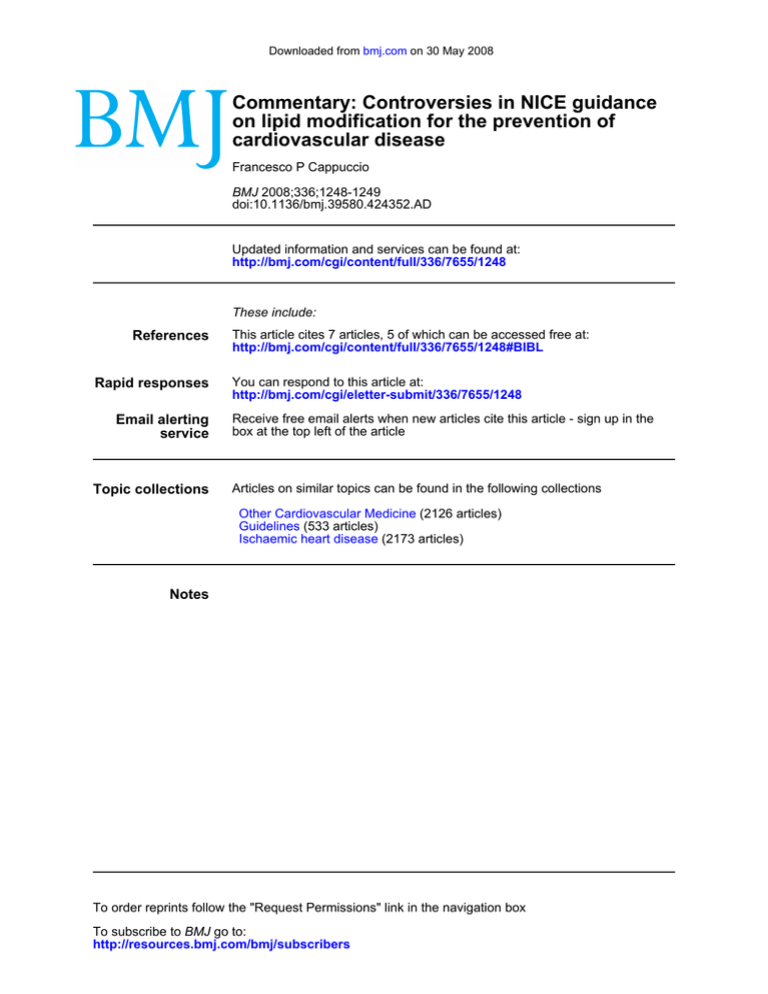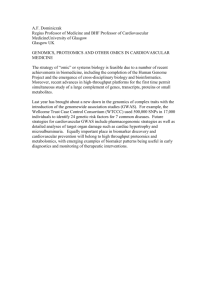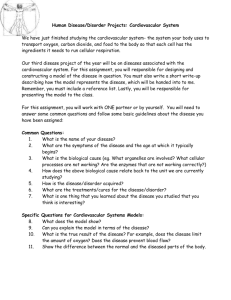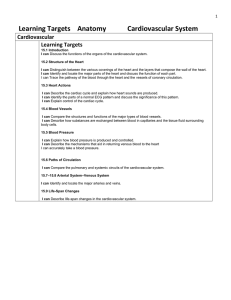
Downloaded from bmj.com on 30 May 2008
Commentary: Controversies in NICE guidance
on lipid modification for the prevention of
cardiovascular disease
Francesco P Cappuccio
BMJ 2008;336;1248-1249
doi:10.1136/bmj.39580.424352.AD
Updated information and services can be found at:
http://bmj.com/cgi/content/full/336/7655/1248
These include:
References
Rapid responses
Email alerting
service
Topic collections
This article cites 7 articles, 5 of which can be accessed free at:
http://bmj.com/cgi/content/full/336/7655/1248#BIBL
You can respond to this article at:
http://bmj.com/cgi/eletter-submit/336/7655/1248
Receive free email alerts when new articles cite this article - sign up in the
box at the top left of the article
Articles on similar topics can be found in the following collections
Other Cardiovascular Medicine (2126 articles)
Guidelines (533 articles)
Ischaemic heart disease (2173 articles)
Notes
To order reprints follow the "Request Permissions" link in the navigation box
To subscribe to BMJ go to:
http://resources.bmj.com/bmj/subscribers
PRACTICE
Downloaded from bmj.com on 30 May 2008
Other lipid lowering agents
Do not routinely offer fibrates or anion exchange
resins for primary or secondary prevention, but
consider either of these options if statins are not
tolerated.
Do not offer nicotinic acid for primary prevention,
but consider it for secondary prevention in people
who cannot tolerate statins.
Do not offer an anion exchange resin, fibrate, or
nicotinic acid combined with a statin for primary
prevention.
Consider people with primary hypercholesterolaemia for ezetimibe treatment (see the NICE technology appraisal on ezetimibe6).
Overcoming barriers
Effectively implementing the recommendations for
primary prevention depends on a structured, systematic approach to identifying people at high risk of
cardiovascular disease. Formal risk assessment will
require good communication with patients and education on the meaning of the risk and the benefits and
risks of treatment. Standard models of care should
include advice and support in lifestyle changes for both
primary and secondary prevention. The costing tool
being developed by NICE can be used to estimate
additional costs (www.nice.org.uk/CG67).
Contributors: Both authors contributed equally to drafting and revising the
summary. NO’F is the guarantor.
Funding: The National Collaborating Centre for Primary Care was
commissioned and funded by the National Institute for Health and Clinical
Excellence to write this summary.
Competing interests: None declared.
Provenance and peer review: Commissioned; not externally peer
reviewed.
1
2
3
4
5
6
National Institute for Health and Clinical Excellence. Lipid
modification: cardiovascular risk assessment and the modification of
blood lipids for the primary and secondary prevention of
cardiovascular disease. London: NICE, 2008. www.nice.org.uk/ CG67
Anderson KM. Cardiovascular disease risk profiles. Am Heart J
1991;121:293-8.
National Institute for Health and Clinical Excellence. Statins for the
prevention of cardiovascular events in patients at increased risk of
developing cardiovascular disease and those with established
cardiovascular disease. London: NICE,
2006. www.nice.org.uk/TA094
National Institute for Health and Clinical Excellence. Hypertension:
management of hypertension in adults in primary care. London: NICE,
2006. www.nice.org.uk/CG34
National Institute for Health and Clinical Excellence. Obesity—the
prevention, identification, assessment and management of
overweight and obesity in adults and treatment. London: NICE,
2006. www.nice.org.uk/CG43
National Institute for Health and Clinical Excellence. Ezetimibe for the
treatment of primary (heterozygous familial and non-familial)
hypercholesterolaemia. London: NICE,
2007. www.nice.org.uk/TA132
Commentary: Controversies in NICE guidance on lipid
modification for the prevention of cardiovascular disease
Francesco P Cappuccio
Clinical Sciences Research
Institute, University of Warwick
Medical School,
Coventry CV2 2DX
f.p.cappuccio@warwick.ac.uk
BMJ 2008;336:1248-9
doi:10.1136/bmj.39554.624086.AD
The new guidelines from the National Institute for
Health and Clinical Excellence (NICE) on lipid
modification for the prevention of cardiovascular
disease will guide the way we assess cardiovascular
risk and treat lipids, both in primary and in secondary
care. What are the new aspects, and what is it that might
spark controversy in this new publication?
Risk assessment
To identify those requiring primary prevention of
cardiovascular disease, the guideline reaffirms the
threshold of a 10 year cardiovascular disease risk
>20% in people aged over 40 years. Its recommendation of a systematic, rather than opportunistic, risk
assessment is welcome, particularly in primary care.
The new guidelines wisely reaffirm the 1991 Framingham risk score as the score of choice for guiding
primary prevention.
However, they also retain subjective, non evidencebased adjustments. They advise increasing the risk
estimate by 1.5-2.0 in the presence of premature family
history and by 1.4 in South Asian men, and suggest
clinical judgment for socioeconomic status and severe
obesity. This is a missed opportunity for tackling at
1248
least some of these matters, such as the ethnic variations
in vascular risk, with an evidence based approach.
The Framingham risk does not perform well in ethnic
groups in the United Kingdom,1 and in the absence of
UK cohort studies with significant proportions of black
and ethnic minority groups, a web based tool
(ETHRISK) has been developed for primary care
physicians to allow for such variation.2 This pragmatic
tool is based on a recalibration of existing Framingham
risk scores against survey data on ethnic group risk
factors and disease prevalence compared with the
general population to produce 10 year risk in seven
British black and ethnic minority groups. This could
have been incorporated into most primary care computer systems. Although the tool is not ideal, its use in
clinical practice would have at least partially prevented
inequalities in cardiovascular disease prevention that are
not easily overcome by subjective judgment.
Lifestyle advice
The approach to lifestyle advice is disappointing. It
perpetuates the belief that, as each listed measure has
been proved to reduce cardiovascular risk, providing
such collective advice will be effective. This is not the
case.3 Maybe a more tailored, patient centred approach
BMJ | 31 MAY 2008 | VOLUME 336
PRACTICE
Downloaded from bmj.com on 30 May 2008
should be used. For instance, focusing on smoking
cessation in a patient who smokes but has normal blood
pressure and is within ideal body weight would be more
effective than offering the entire preventive package.
Having said this, the list of effective measures for
primary prevention has a glaring omission: it fails to
mention reducing salt intake as a tool to prevent
cardiovascular disease through blood pressure control,
as recently reaffirmed by the World Health
Organization.4 5
Statins and targeting cholesterol levels
The NICE guidelines now recommend the use of
statins for the primary prevention of cardiovascular
disease in adults who have a 10 year cardiovascular
disease risk >20%. They reinforce the preferential use
of simvastatin for primary prevention, as supported by
both intervention trials on cardiovascular end points
and by economic appraisal. Lower dose pravastatin is
recommended as a cheap alternative, but this neglects
compelling data from the randomised controlled
ASCOT trial,6 which used low dose atorvastatin
(10 mg once daily) in high risk patients such as those
targeted by the current guidelines. The study was
stopped earlier than planned (median follow-up 3.
3 years rather than 5 years) owing to the large reduction
in major cardiovascular events in the intervention
group (36%; 95% confidence interval 17% to 50%).
Finally, for secondary prevention, the guidance
reaffirms the need to increase statin doses until total
cholesterol is <4.0 mmol/l, or low density lipoprotein
cholesterol is <2.0 mmol/l, as in the Joint British
Societies’ JBS 2 guidelines.7 Introducing an “audit
level” of cholesterol and an “ideal target” resembles the
useful approach advocated in the British Hypertension
Society’s hypertension guidelines.8
Conclusion
Although the new NICE guidance on lipid modification comes closer to other guidelines issued by
professional societies, it misses important opportunities for further improvement. It has taken two steps
forward and one back—slow progress but progress.
Contributors: FPC is the sole contributor.
Competing interests: None declared.
1
2
3
4
5
6
7
8
Cappuccio FP, Oakeshott P, Strazzullo P, Kerry SM. Application of
Framingham risk estimates to ethnic minorities in the UK and
implications for primary prevention in general practice: a cross
sectional population based study. BMJ 2002;325:1271-4.
Brindle P, May M, Gill P, Cappuccio FP, D’Agostino R Sr, Fischbacher C,
et al. Primary prevention of cardiovascular disease: a web-based risk
score for seven British black and minority ethnic groups. Heart
2006;92:1595-602.
Little P, Kelly J, Barnett J, Dorward M, Margetts B, Warm D. Randomised
controlled factorial trial of dietary advice for patients with a single high
blood pressure reading in primary care. BMJ 2004;328:1054-7.
World Health Organization. Reducing salt intake in populations:
report of a WHO forum and technical meeting. Geneva: WHO,
2007:1-60.
Cappuccio FP. Salt and cardiovascular disease. BMJ
2007;334:859-60.
Sever PS, Dahlöf B, Poulter NR, Wedel H, Beevers G, Caulfield M, et al.
Prevention of coronary and stroke events with atorvastatin in
hypertensive patients who have average or lower-than-average
cholesterol concentrations, in the Anglo-Scandinavian Cardiac
Outcomes Trial-Lipid Lowering Arm (ASCOT-LLA): a multicentre
randomized controlled trial. Lancet 2003;361:1149-58.
British Cardiac Society, British Hypertension Society, Diabetes UK,
HEART UK, Primary Care Cardiovascular Society, Stroke Association.
JBS 2: Joint British Societies’ guidelines on prevention of
cardiovascular disease in clinical practice. Heart
2005;91(suppl 5):v1-52.
Williams B, Poulter NR, Brown MJ, Davis M, McInnes GT, Potter JF, et al.
Guidelines for management of hypertension: report of the fourth
working party of the British Hypertension Society, 2004-BHS IV. J Hum
Hypertens 2004;18:139-85.
Rubber gloves
The manager of the older people’s mental health day
assessment unit was sitting with her feet on the desk, a
broad grin on her face, and a red box in her hand,
telephoning the supplies department. The box had been
unpacked by the unit’s cleaner and was found to contain,
rather than the 200 non-latex gloves she had ordered, 200
non-latex condoms.
The manager finally managed to persuade the supplies
receptionist that these were not really what we wanted and
that the gloves were a more useful alternative, and the
budget didn’t stretch to both. But were they not what we
wanted?
In the emotionally safe environment of the day unit,
we found that many patients had been revealing to us
their sexual worries, and their self perceived sexual
misdemeanours. The number of such discussions had
been increasing to the extent that a training workshop
for staff was organised for us to learn more about
relationship and sexual needs of older people. This
was a thought provoking, though somewhat giggly,
session. It emphasised that we can talk with older people
about sexual matters, and we became better able to
understand the underlying issues when “inappropriate”
BMJ | 31 MAY 2008 | VOLUME 336
sexual activity in people with dementia is reported by
families or carers in homes and sheltered flats.
For a sensible introduction to sex in old age, try the
Help the Aged website, www.helptheaged.org.uk/en-gb/.
Despite its antiquated name (who else uses the term “aged”
these days?) it is extremely forward thinking.
Another myth of activity in old age is that older
people do not use the internet. If you are an older person
interested in sex, in old relationships and new, take
a look at the website—and follow the website’s safety
advice: “If you are starting out on a new sexual
relationship it is important, if a little unromantic, to
think about your sexual health. Not having to worry
about unwanted pregnancies does not mean that you
should throw caution to the wind: sexually transmitted
diseases are on the increase in the UK, and it’s not all
down to young people.”
Should we have kept the condoms?
Claire Hilton consultant
Mental Health Service for Older Adults,
Northwick Park Hospital, Harrow
claire.hilton@nhs.net
1249









